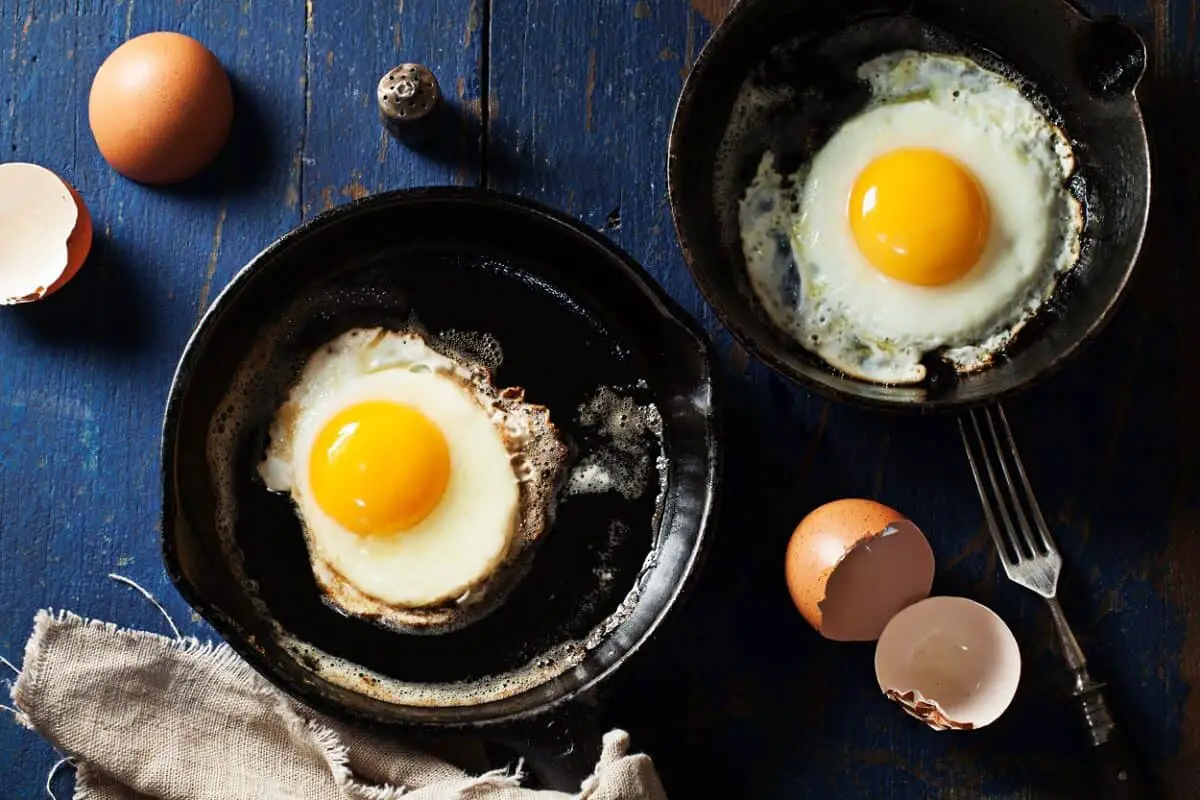Last Updated on 23rd April 2022 by
It’s so easy to cook eggs in a Teflon-coated or nonstick pan. You don’t even need to add oil or water to keep the eggs from sticking, and they come out perfectly, whether you are preparing your eggs sunny side up, easy over or scrambled. By not needing to use any oil, you might think you are making your food healthier. You may not realise the dangers lurking in Teflon-coated skillets.
What many people don’t know is that non-stick pans can release chemicals into the air and into food when heated. If you have used a nonstick pan for a while, then you probably notice that it lost its non-sticking properties after repeated use. With repeated use, the surface of the pan becomes like a typical skillet and food starts to stick to it.
The chemicals from the pan are contaminating your food and may have an effect on you over time. These chemicals make it easy to cook without oil, but they aren’t good for you, and it’s time to give up the nonstick pan for your health’s sake. Instead, you can use a cast iron skillet and not risk any harmful chemicals.
We definitely recommend cast iron skillet cooking as the way to go for making eggs in a healthy and safe way. But how to cook eggs in cast iron without sticking? That can be a tough one, especially for people who want to eat healthy. We have some help for you, though, and we’ll show you how to use your cast iron to cook eggs and other food.
Cooking with Oil
First off, this is how most people cook their eggs, bacon and other food in a cast iron skillet, and there’s nothing wrong with it. It’s the tried and true method because it is easy and it works. There are a few ways to keep from clogging up your arteries and still use oil for easy cast iron skillet cooking.
The first method to keep it healthy is to use only enough to cover the surface of the pan. You can just put a few drops into the bottom of your cast iron skillet and then use your hand or a paper towel to spread the oil around evenly. The thinnest coating is all that’s necessary.
A spray oil works as well and does a great job of adding enough coverage without overdoing it. Just hold the spray can up high enough so that one or two sprays can cover the entire pan. If you hold it too closely to the pan, you won’t cover much of the pan at once and you will have a thicker, more concentrated spray.
Another way to use oil in your cooking in a healthy way is to use a healthy oil. You don’t have to cook with canola, corn, or vegetable oil. You can use olive oil (but it is expensive) or coconut oil. Any of the LDL oils are a good choice, as these are heart healthy for you compared to HDL oils. That doesn’t mean you can fill your pan with olive oil and still have a healthy meal, but it is definitely healthier than the cheaper, more common oils.
You can also cook with butter or margarine. These aren’t usually healthy, but if you plan to add butter to your food anyway, why not cook with it and save yourself some oil while adding the butter flavour you want? You may just cut down on some of the overall fat this way.
Cooking with Water
Here is a method for how to cook eggs in a cast iron skillet and keep them from sticking that you might not have heard of. Did you know that you can cook with water and get similar results to cooking with oil. It won’t fry your food, but it will cook it. You only need a little bit of water on the bottom of the pan, and that’s enough to make flavourful, tasty eggs or bacon.
Cook the eggs like you normally would, but be aware of how the heat can dry out the pan by evaporating the water. Eggs don’t take long to cook, even on a low heat, so there isn’t much risk of the pan drying out, but you probably want to keep a cup of water handy in case the pan goes dry while cooking. If that happens, the eggs will stick to the skillet and may burn or become tough to remove fully and cleanly.
One of the toughest ways to cook eggs in a skillet with water is easy over. This takes a longer time than most other egg dishes and requires that you keep the egg mostly in one place as you cook. There is a higher chance that the water will evaporate and your food will burn or stick slightly. Like we said, though, if you just keep some water handy and add it as necessary, your eggs will cook just fine.
The easiest way to cook eggs with water is scrambled. If they start to stick at all, it doesn’t matter, since you can unstick them with the spatula and keep cooking. Add water as needed to the scrambled eggs. What makes this such an easy dish to make in a skillet with water is that it doesn’t matter how they look when they are finished, as long as your scrambled eggs are not burnt. So, if cooking this way gives you a bit of trouble, no one will likely notice.
What Other Liquids Can Be Used
How to cook eggs in cast iron without water or oil? You can use different liquids that may flavour the food or cook it in slightly different ways. Any broth or stock will work just fine, cooking similarly to water, so be careful about your stock evaporating too quickly. It’s best to cook on a low, steady heat when cooking with water or a watery liquid.
You can also use wine or soy sauce for your cooking. Honestly, anything that’s watery or oily should work great. Just be careful about how much you use and how it will flavour the food.
You Don’t Always Need to Add a Liquid
How to cook bacon and eggs in a cast iron skillet? If you are cooking both of these foods and you want to keep it as healthy as possible, we suggest cooking your bacon first. The beautiful thing about frying up bacon is that it cooks in its own fat, and it’s not the only food that does that. You don’t need to add any oil, because once the bacon warms up, it produces its own oil and will cook in that.
Then once you take out the bacon, you can add in the eggs and cook them in that same bacon grease. Or you can even cook the eggs and bacon together if you are making a breakfast scramble.
To keep the food healthy, you may want to dab the bacon dry with a paper towel to remove excess grease. You can do the same for the eggs, if you like.
Some meats will cook in their own fats, and cooking meat without any oil or water in the pan is called pan searing. You should only try this with thin cuts of meat or with meats that produce their own oil when cooking.
Why Worry about Your Food Sticking to the Pan?
What’s the problem with having a little food stuck to the pan? For one, it’s a waste of food. Any of your eggs or other food that you can’t remove from the pan will be less food for you to eat. It’s a waste, and you want to try to avoid that.
Another reason to avoid letting your food stick to the pan is that it can burn the food slightly. If you want your food to taste flavourful and properly cooked, then it shouldn’t be sticking to the pan. That also dries out the food, robbing it of the proper texture and making it less appealing.
This is why it is so important to grease or cover the pan with a liquid and watch your cooking temperature closely to ensure food doesn’t start sticking to the pan.
Easy Methods for Cooking Eggs
Would you like your eggs to turn out perfectly every time? We have given you a few pointers about greasing the pan and controlling your temperature, but let’s talk about how to cook scrambled eggs in a cast iron skillet and how you can make other egg dishes easily with this kitchen utensil.
You’ll be using a spatula for all of these egg dishes, and the spatula should be plastic, have a plastic handle or be made from some other material that doesn’t conduct heat. You don’t want your hand getting hot while you cook.
Eggs are typically cooked on a low, even heat. Scrambled eggs can be made on a high heat, but you still have to watch overcooking them and drying them out, which is easier to control on a low heat setting.
All of these methods assume your dish is greased or covered in a liquid before cooking to prevent sticking.
Scrambled Eggs – Crack your eggs into the pan, and you can use as many eggs as you want, so long as they don’t start piling on top of each other. A typical 8-inch skillet will easily accommodate four or five large eggs at once for scrambled eggs. Turn your heat on low and start spreading the eggs around, slicing through them with the tip of the spatula. When making scrambled eggs, hold your spatula by the handle with the utensil turned upside down. Move the spatula back and forth through the eggs, separating and cutting them into smaller pieces as they cook. The tip of the spatula easily cuts through the eggs. Once the eggs have lost their shiny, wet look, they are done.
Sunny Side Up Eggs– Crack your egg into the centre of the pan. It is best to cook just one egg at a time for easier control over its shape and how well it is cooked. Turn the heat on low and allow the egg to sit there until the white edges start to brown. They may curl slightly. Once the white of the egg is cooked, you can lift the egg onto your plate. (Note, consuming raw eggs caries the risk of salmonella or food poisoning).
Easy Over Eggs– Use the same method for making sunny side up eggs but flip over before removing from the pan. Let the egg cook on that side for about 30 seconds and then remove from the pan.
Omelette– You want your omelet to be fluffy, so you should crack two eggs into a bowl and add a tablespoon of milk. Prepare all of the fillings for your omelet, like cheese, tomatoes, ham, bacon, green peppers, etc. Whisk vigorously for about a minute and then add to your skillet. Pour the egg and milk mixture evenly across the entire skillet, with a single layer. Turn on a low heat under the skillet. Once the egg starts to solidify, you can add in your fillings to one half of the omelet. Then, flip the empty half of the omelet over the filled side. You may need to flip the entire omelet over at that point to finish cooking the top. It should only take a few seconds to finish cooking the omelet at that point.
I'm Pauline, a mother of four grown children, my passion for cooking stemmed from the joy i get cooking for my family. I love to try new dishes, especially when dining out but creating and sharing my own recipes is my favourite thing to do!


